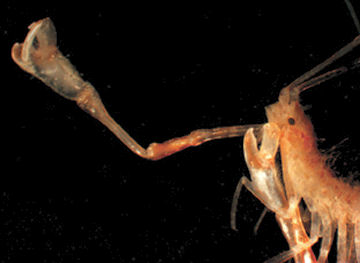Life on the Down Low
The first scientific survey of organisms in the deep waters off Antarctica has discovered lots of life.
By J. L. Pegg
There are few places that scientists haven’t explored. In their searches for exotic life on Earth, researchers have ventured into even the driest deserts and the steamiest jungles.
But conditions in the deep ocean are so extreme that very little is known about life at the bottom of the sea. The deep sea is one of Earth’s last frontiers.
Now, a team of scientists from eight countries has completed the first survey of life in the deep waters off Antarctica.
 |
|
This isopod from the depths of the Southern Ocean has long legs, unlike the stubby ones of pill bugs, which are its terrestrial cousins.
|
| W. Brökeland |
The team worked aboard a German icebreaker called Polarstern. An icebreaker is a special ship that can withstand strong storms and push through ice on the water’s surface.
To catch deep-sea creatures, the team lowered a scoop to the ocean floor. It took 6 to 8 hours to lower and raise the scoop just once. The sampling sites were up to 4 miles below the ocean’s surface.
The effort was worthwhile. Before this expedition, researchers had thought that few creatures would be able to live in the harsh Antarctic ocean conditions. They thought deep-sea life would be less diverse than life in warmer waters.
But the scientists were in for a surprise. They found unexpected diversity among deep-sea creatures. What’s more, many of these creatures had never before been seen. For example, of the 674 species of isopods picked up by the team, 585 were new to science. (Isopods are a type of crustacean that includes pill bugs, little grey bugs found in many gardens.) That’s more new isopod species than have been found in shallower Antarctic waters in the entire past century.
Researchers also found other surprises, including carnivorous (meat-eating) sponges.
The sponges and most of the other bottom dwellers that the researchers found were largely white. No light reaches such depths, so most are blind.
How do these organisms survive in the frigid, inky-black waters? First of all, their bodies are specially adapted to the cold. And when it comes to food, many are scavengers. Their diets consist mainly of debris (little pieces of carcasses and food excreted by other animals) that drifts down from above. Scientists call this debris “marine snow.” By the time some of this debris gets to these deep-water creatures, it’s already made its way through the bodies of two or three other sea creatures, the researchers say.
Many questions remain about how the creatures can survive in such harsh conditions. The deep-sea dwellers collected by the team may provide answers. The data will also help scientists figure out how ocean species migrate and how their ecosystems develop. There’s a lot of ocean left to explore!—J.L. Pegg
Going Deeper:
Milius, Susan. 2007. Low life: Cold, polar ocean looks surprisingly rich. Science News 171(May 19):308. Available at http://sciencenews.org/articles/20070519/fob3.asp .
Sohn, Emily. 2004. Explorer of the extreme deep. Science News for Kids (Nov. 10). Available at http://sciencenewsforkids.org/articles/20041110/Feature1.asp .







